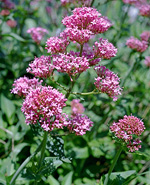 |
This Northern Hemisphere temperate family is represented in Australia only by a few garden plants that occasionally escape cultivation as minor weeds of disturbed sites in the southern States.
Characteristic features of the family Valerianaceae in Australia include: - herbs with opposite, entire or often deeply toothed or divided leaves
- flowers borne in large, terminal, much-branched cymes, white or pink to red, strongly zygomorphic with a narrowly tubular corolla and 5 spreading lobes
- stamens 1, 2 or 3, they and the style usually strongly exserted from
the corolla tube
- fruit dry, indehiscent, with a terminal fringe of long hairs like a daisy-seed
Description
Perennial terrestrial herbs. Perennating by taproots or crowns. Stem internodes solid or hollow. Internal secretions not obvious. Plants glabrous. Leaves opposite, both basal and cauline, petiolate; pulvinae present. Stipules and stipellae absent. Lamina simple or once compound, imparipinnate, symmetric; pinnatifid or pinnatisect, lanceolate or ovate; base cuneate or attenuate; margins entire, dentate or serrate, ±flat; one-veined, or venation pinnate, with the midrib conspicuous, and the tertiary venation not reticulate; surfaces not punctate; herbaceous. All the flowers bisexual. Inflorescences terminal or axillary, consisting of dichasial cymes. Bracts and bracteoles present. Pollination by insects. Flowers odourless or fragrant, sessile or stalked. Floral disc absent; nectaries present on the perianth. Perianth of 2 dissimilar whorls or apparently of 1 whorl only (the outer whorl becoming ±vestigial early), with 10 or apparently 5 segments. Calyx regular; segments fused, with (0–) 5 lobes, imbricate or valvate in bud; calyx urn-shaped or tubular, herbaceous or papery. Corolla irregular; segments fused, with 5 lobes, alternating with the calyx lobes, valvate in bud; corolla tubular, 1-lipped, white, cream, pink, magenta, red or purple, without contrasting markings, or streaked, spotted, etc, membranous; claws absent; lobes ±entire; base spurred, or without appendages. Fertile stamens 1–3, not clearly correlated with the calyx lobes, at least partly fused to the corolla, free of the ovary and style, distinct from each other, all ±equal. Anthers basifixed or ?dorsifixed, versatile, opening inwards by longitudinal slits, 2-celled. Ovary inferior. Carpels 3, fused; ovary with 1 locule. Style terminal, single and unbranched and the stigma capitate. Ovule 1, stalked; placentation apical. Fruit a dry indehiscent cypsela or diclesium (an achene with a loose covering of perianth); the perianth on the maturing fruit deciduous, dry and persistent, or growing larger. Disseminule macro-surface featureless or with a pappus of hairs; micro-surface ±smooth, cream, yellow, brown or grey, dull. Seeds 1 per fruit. Aril absent. Cotyledons 2. Embryo straight.
(Note: this description has been generated from the coded data compiled for the key. Any errors in the key data will be reflected in the descriptions.)
A treatment of the family Valerianaceae has not yet been published in the Flora of Australia. It will appear in Volume 36.
Australian genera of Valerianaceae (as recognised for the Flora of Australia)
* = all species introduced
*Centranthus
*Fedia
*Valerianella

|
  |

Centranthus ruber (flowers)
Photo: K.Thiele © ABRS
|
 |
|